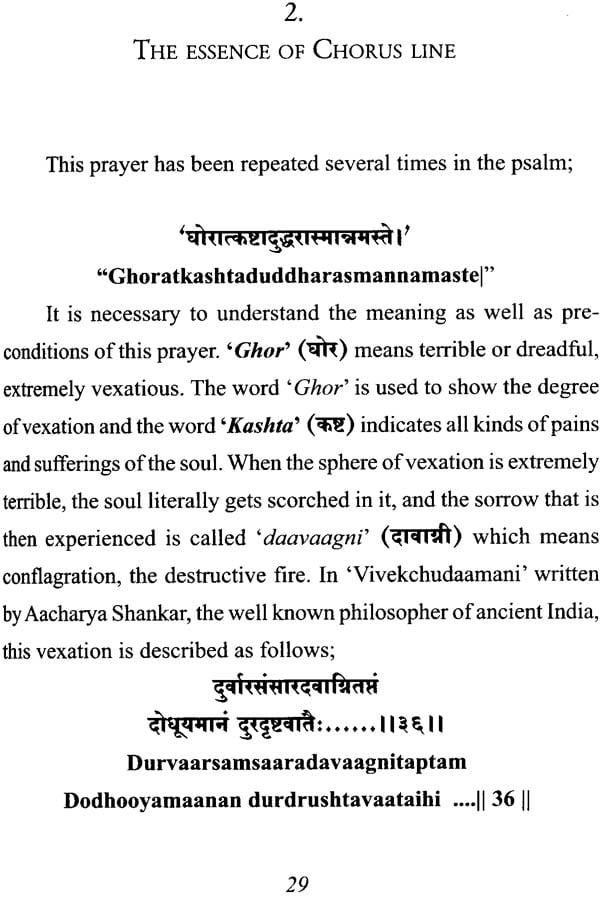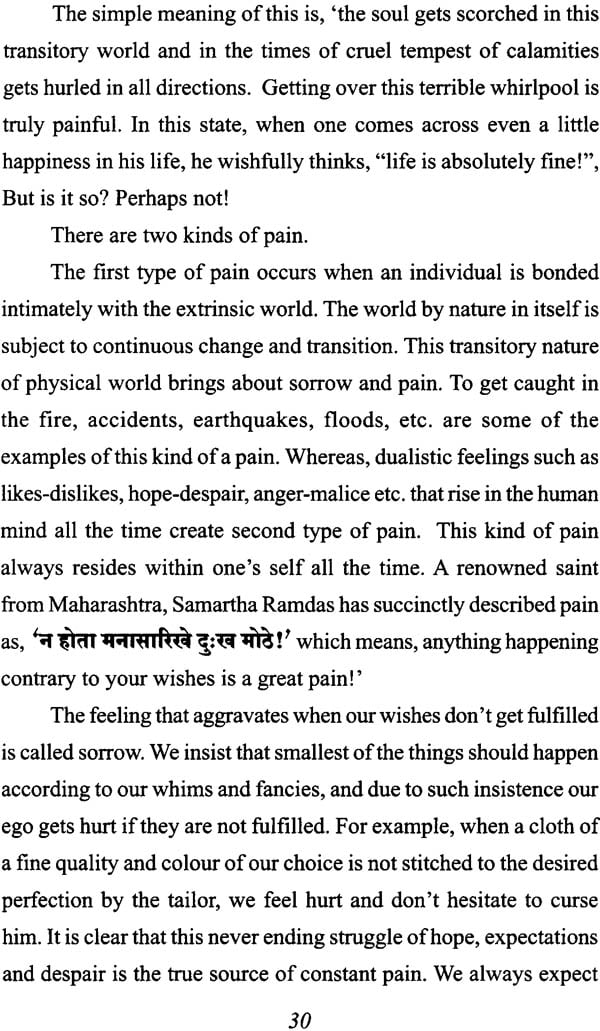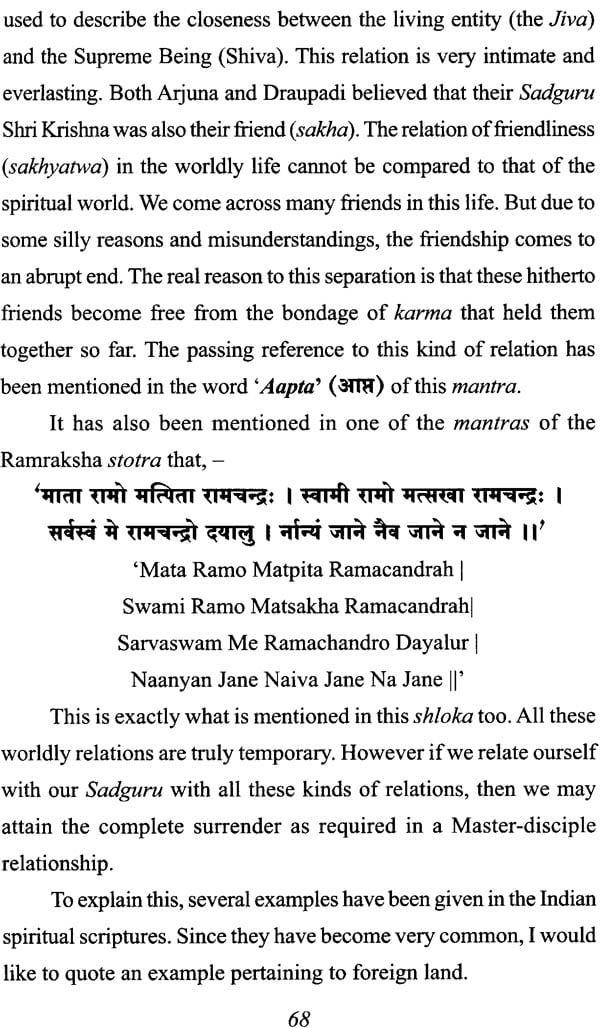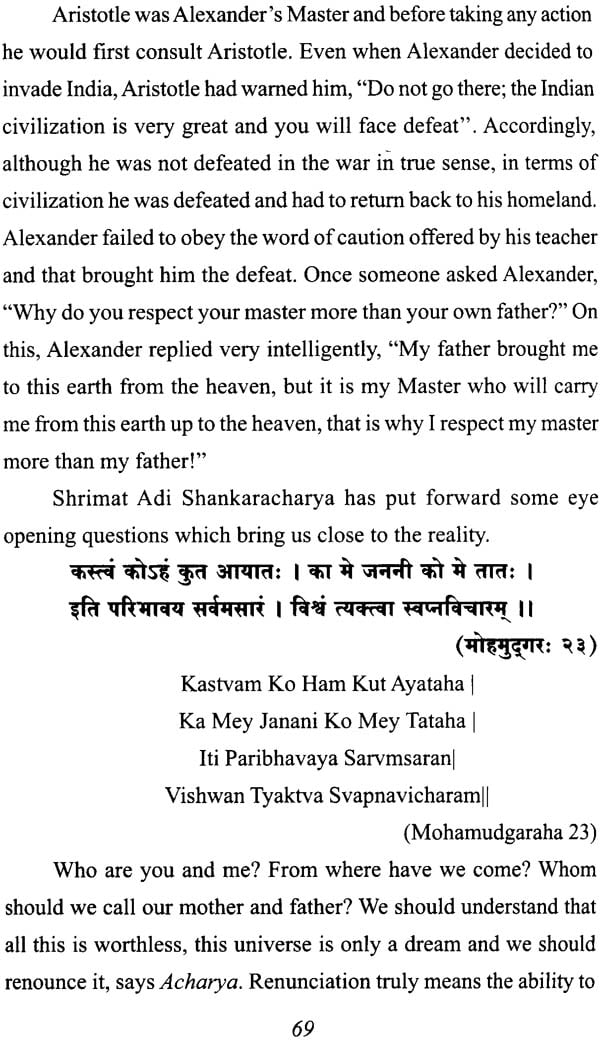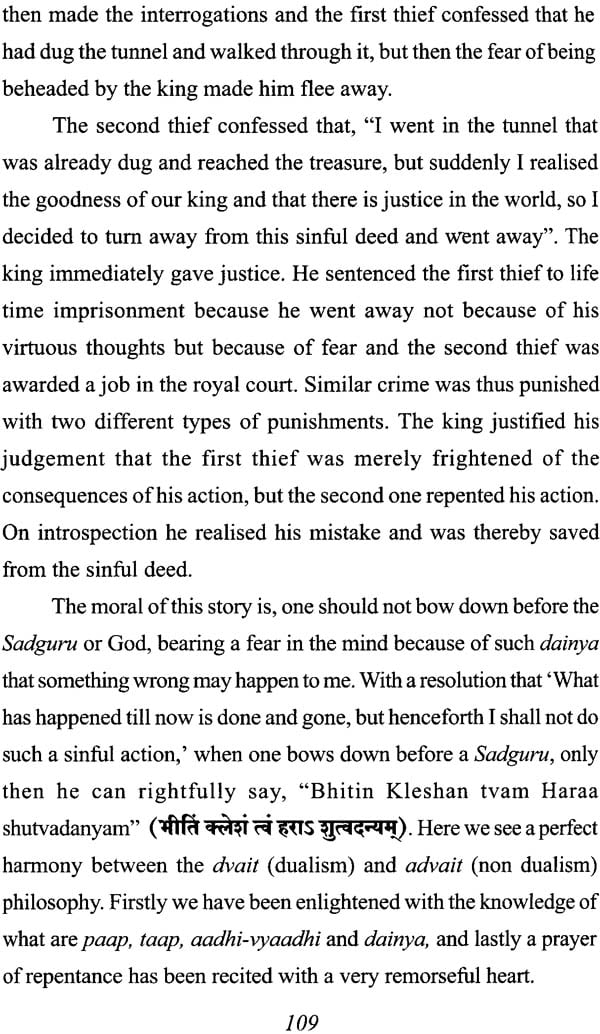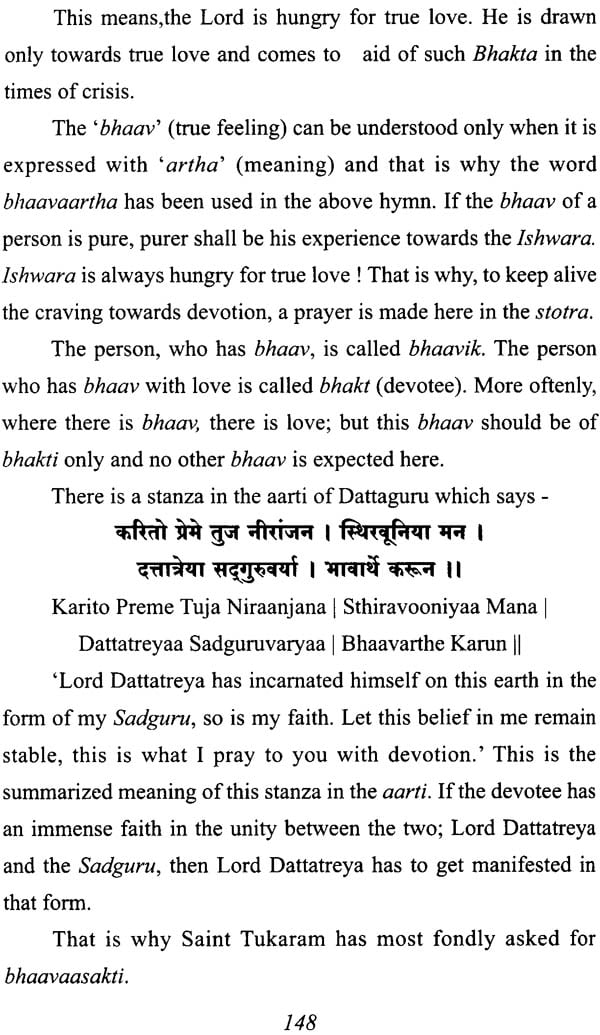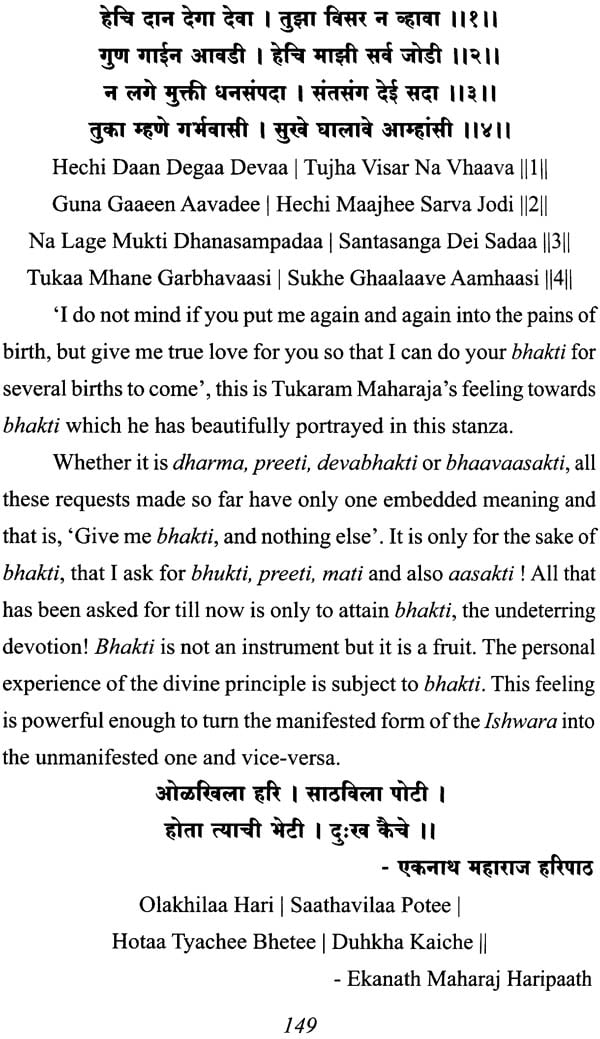
(A)ghorakashtoddharana Stotra (The Entire Substance and Interpretation)
Book Specification
| Item Code: | NAK029 |
| Author: | Shri Vasudeo Vaman Bapat Guruji |
| Publisher: | Keshav Bhikaji Dhawale |
| Language: | Sanskrit Text With Transliteration and English Translation |
| Edition: | 2014 |
| ISBN: | 9789383804450 |
| Pages: | 168 |
| Cover: | Paperback |
| Other Details | 9.0 inch x 6.0 inch |
| Weight | 230 gm |
Book Description
Paramahansa Parivrajakacharya shrimat vasudevananda Saraswati Swami Maharaj was an eminent saint who holds a very respectable place in the heart of every devotee of the Dattasampradya. Like Shrimat Adi Shankaracharya, Maharaj also travelled barefoot all over India for all his life to spread the principles of Vedic dharma and the devotion towards Lord Dattatreya amongst the people.
Swami Maharaj has composed many spiritual volumes in Sanskrit and in Prakrit. His composition of (A)ghorakashtoddharana stotra is well-known amongst the Dattasampradaya and is recited regularly in many Datta temples.
Every year, 108 Satya Datta Pooja ceremony is held at the moortisthan of Paramashansa Parivrajakacharya Shrimat Vasudevananda Saraswati Swami Maharaj at Khopoli in Maharashtra. During this ceremony, Paramapoojya Sadguru Shri Bapat Guruji delivers a series of discourses on Swami Maharaj's selected compositions in a very simple language to simplify the path of devotion for thedevotees of Lord Dattatreya.
During the Satya Datta Pooja held at Khopoli sthan on August 24 to 26 in the year 2008, Shri Guruji gave discourses on Swami Maharaj's composition (A) ghorakashtoddharana stotra and on the auspicious occasion of Dattajayanti of the same year, a book in Marathi titled (A)ghorakashtoddharana stotra sampoorna Artha Ani Vivechan' was published. Subsequently in the year 2009, the Gujarati translation of this book was also published on the occasion of Shri Krishna Jayanti. Upon a good response and demand from the devotees, the reprint of the original Marathi book was published in the year 2009 on the auspicious day of Akshaya Tritiya. By the grace of the Sadguru, the Hindi version of this book was also published in 2011. With the second edition of Marathi version published in the year 2014 the total sale of Marathi version itself has crossed the number of 4000 till now.
It now gives us immense pleasure to present the English version of this book for the reading of non-marathi speaking devotees. The text is kept simple so that even a layperson will be able to grasp the spiritual intricacies of the stotra. We appreciate the painstaking efforts taken by the devotees to present this English version. The foreword to this English book is given by Poojya Srimat Virajananda Saraswati Maharaj of Mysore, Poojya Swamiji Holds a post Graduate degree in English literature. In his younger days, he studied the Shankar Bhasya on Prasthantrayi at Gurukul Ashram in Holenarsipur in Karnataka. He was initiated in Sanyasa Ashram by his Diksha Guru Shri Shri Sahajananda Saraswati Swami Maharaj in the year1996.
Swamiji is deeply influenced by the Advait philosophy of Shrimat Adi Shankaracharya. He is also an ardent follower of the teachings of Shri Ramakrishna Paramahansa and Bhagwan Ramana maharshi. Swamiji delivers taks and lectures on various spiritual topics. He has authored more than 16 spiritual books till date. The Silent Mind "Selections from Ramana Geeta" are some of his popular works. Swamiji presently resides in his Ashram "Sadguru Sadana" at Hinkal, Mysore in Karnataka. He imparts knowledge and blessings to his devotees that are sqread all over in india and abroad
We pray to Sadgurutatva that every reader of this book is blessed with the divine grace of Paramahansa Parivrajakacharya Shrimat Vasudevananda Saraswati Tembe Swami Maharaj!
It gives me great pleasure to write a foreword to the English translation of (A) ghorakashtoddharana Stotra.
The panchaka in Sanskrit is originally a work of paramahansa Parivrajakacharya Shrimat Vasudevananda Saraswati (Tembe Maharaj). Shri Shri Tembe Maharaj was a great scholar both in Sanskrit and Marathi. He was a prolific writer and his contribution to Datta Sahitya is immense. He is considered as the third Avtar of Lord Dattatreya.
His present composition is well –konwn amongst the devotees of Datta and it is being recited daily as a part of nityanushthana by a good number of Dattabhaktas in their homes.
Paramapoojya Sadguru Shri Vasudeo Vaman Bapat Miharaj Gave a series of discourses at Khopoli shrine of Shri Shri Tembe Maharaj during 2008. On the auspicious occasion of Dattajayanti a book in Marathi was published based on his talks. The same has also been translated and published in Gujarati and Hindi.
The present English translation was a crying was a crying need felt by devotees who are not familiar with prakrit. The subject matter of the stotra,as is evident from the title, is a petition for protection from Ghorakashta. It is said that the human life, from birth to death, is one series of calamities. But those who surrender to Sadguru need not fear. Guru is the protector. Is not he the Trimurtiswaroopa?
Sadguru Bapat Maharaj dwells on the significance of every word in the original stotra and brings out not only literal but implied meaning. His deep knowledge of the scriptures is evident. Moreover he is a Anubhavi. His style is simple and pleasing. & he amplifies his prints with many anecdotes and humorous stories. On the whole it makes a very entertaining and also enlightening experience.
I congratulate and bless all those who have rendered service in bringing out this English edition. I pray to Lord Datta that He enables them many such books to get Published.
The smallest particle of dust on the feet of the Sadguru
The purpose of stotra: this canticle though small in size, is very powerful. This apparently simple looking stotra has indepth meaning and tremendous energy. The whole canticle can be treated as mahamantra like RamRaksha stotra. In (A) ghorakashtoddharana Stotra as well, every psalm is independently treated as a mantra (sacred hymn or text), which has the strength to fulfil the wordly and spiritual needs and desires. Every psalm of this stotra has a different kind of power. To understand this, let us take the example to sunrays.
Sunrays have seven colours and every colour has a different power. The energy in every colour is a remedy for some or the some or the other deficiency. Because of the variedness of energy contents in each colour, the choice of a colour varies from and individual to an individual depending upon the personality of that individual. Only the wise can judge the suitability of these colours for an individual and can guide so. In modern science, there is a device called Strodoscope through which the benefit of a particular colour can be suggested. A research was undertaken through 'Kirlin' photo technique on the energy waves created by both the individual and collective recitation of the Gayatri Mantra. This type of research has not been undertaken so far using modern scientific technique on this stotra. If such research is ever done in future, then the convincingly in this stotra can be brought before the society more substance in this stotra can be brought before the society more convincingly. The collective recitation of any psalm or a canticle produces very high amount of energy. Hence, the collective recitation of such a powerful canticle like (A) ghorakashtoddharana Stotra as compared to the individual recitation is far better, because in the collective recitation, the co-ordination of all forms of energy within it is achieved.
The historical background:
Shri Swami Maharaj did his 21 Chaturmasa (a period of four mouths during monsoon during which some specific observances are enjoined. In case of sanyasis, the period lasts for two months) in the sacred place of Kuravpur. Shri Shesho Karadgikar from Kolhapur was a great devotee of Swami Maharaj. He was childless and was also in financial crisis. As per the ascetic rules, Swami Maharaj would travel barefoot from one place to another. During His 21 Chaturmas when Swami Maharaj was residing in the holy place Kuravpur, shri Shesho Karadgikar along with his learned wife came to pay their respects to Swami Maharaj and in a very pitiful voice Shesho placed his agony before him, Swami Maharaj gave Shri Karadgikar's wife a coconut and some grains and blessed them by saying "both your wishes shall be fulfilled" soon after with some medications the couple was blessed with a son and a daughter and they were also relieved from their debts.
If a man is honest to himself, he will definitely introspect and then he will realize, that the fruits he is enjoying are not only because of his good deeds or merits, but there is some energy, some divine power behind such blessings. Shri Shesho Karadgikar realized this and felt that other people should also be happy just like him and be freed from their sorrows. He prayed to Swami Maharaj, "There are many people like me, who are suffering, helpless and are struggling to overcome their sorrows. Due to ignorance they are unaware of the remedy to their pains". He pladed to bless all those who are wandering in the dark, so as to enable them to come out of their sorrows and praise of Shripad shri Vallabh, the first incarnation of Lord Dattatreya.
| 1 | Introduction | 15 |
| 2 | The Essence of Chorus Line | 29 |
| 3 | First Mantra | 42 |
| 4 | Second Mantra | 66 |
| 5 | Third Mantra | 87 |
| 6 | Fourth Mantra | 112 |
| 7 | Fifth Mantra | 129 |
| 8 | Sixth Mantra | 151 |
| 9 | Epilogue | 153 |
| Brief Introduction of Paramapoojya Sadguru Shri Vasudeo Vaman Bapat Guruji | 160 | |
| List of References | 163 | |
| Appendix | 165 |
